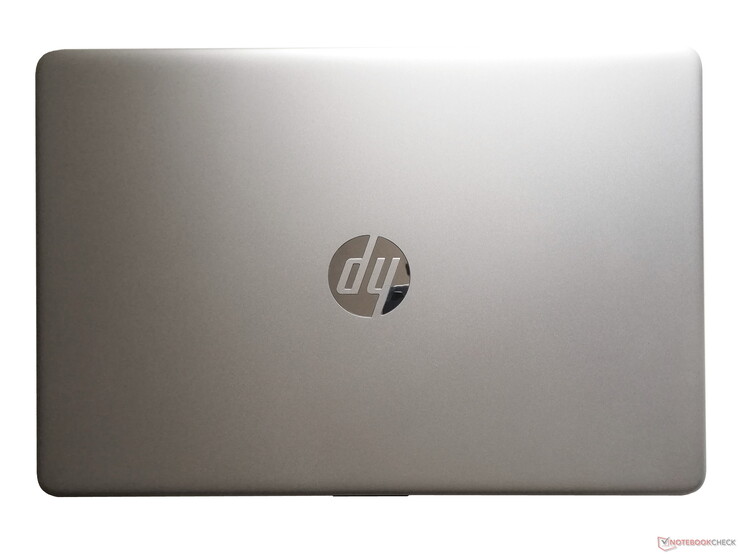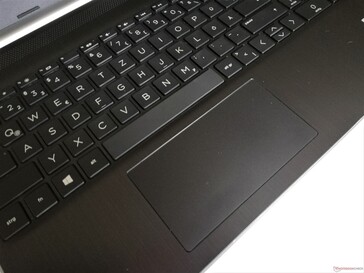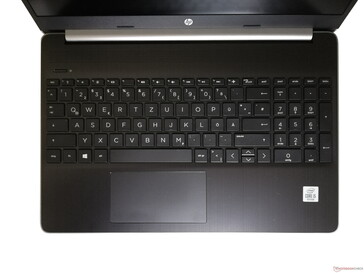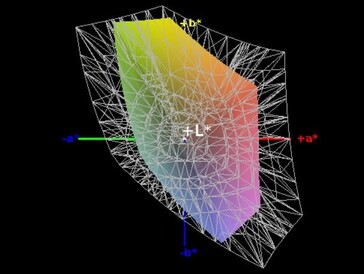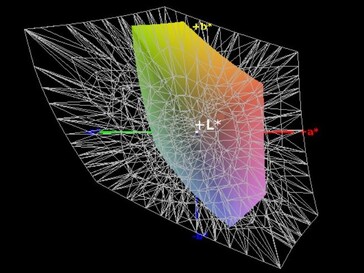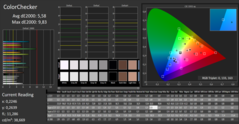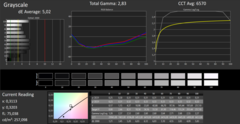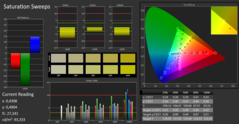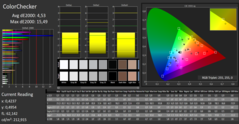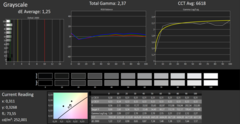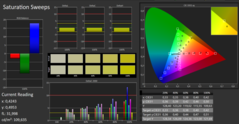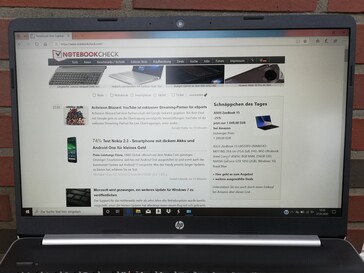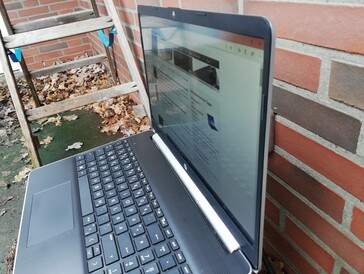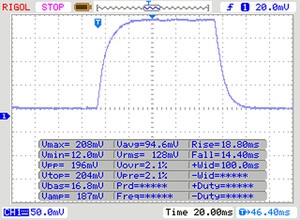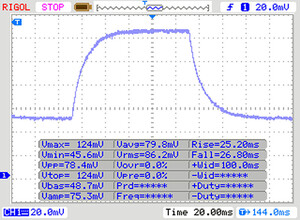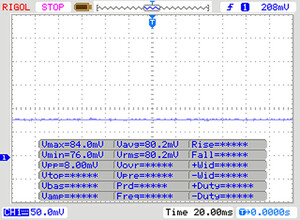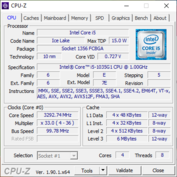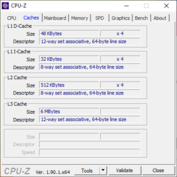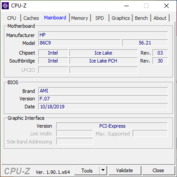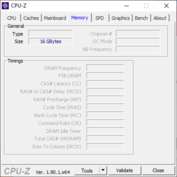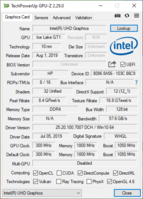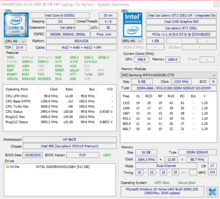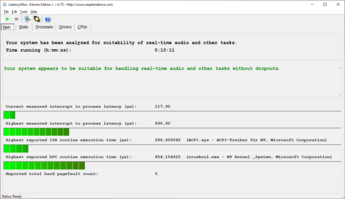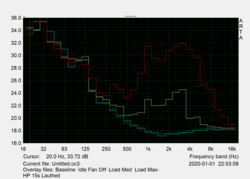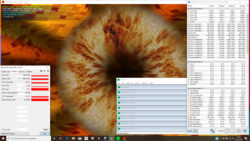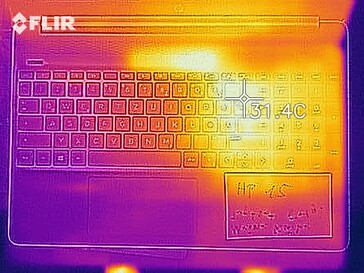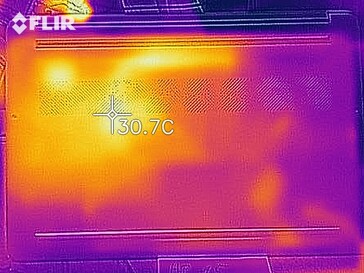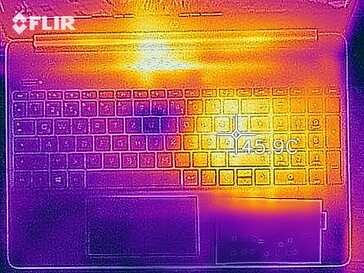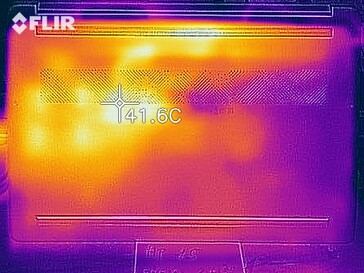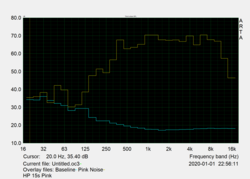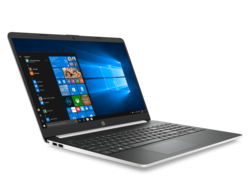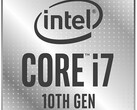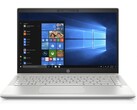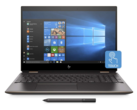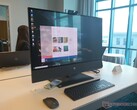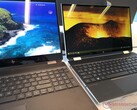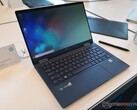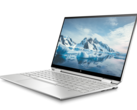HP Notebook 15s Laptop Review: With Ice Lake CPU and Slim Design
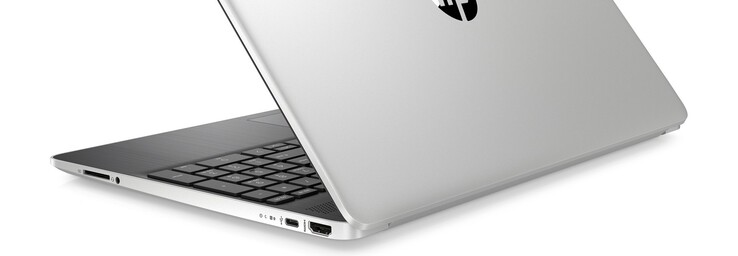
With its notebooks, HP covers the whole range from affordable to expensive devices and from entry-level, through business, and up to gaming laptops. Correspondingly, the price also ranges from the expensive 2500-Euro (~$2757) HP EliteBook-x360-830-G6 Convertible down to the affordable 600-Euro (~$662) HP ProBook 455R G6. For a similar price, you can also get the HP 15s-fq1556ng, which is equipped with an Intel Core i5-1035G1, integrated UHD Graphics G1, 16 GB of RAM, and a 512-GB SSD.
For this test, we compare the HP notebook with the devices listed below. You can also add more laptops from our database below each section.
Rating | Date | Model | Weight | Height | Size | Resolution | Price |
|---|---|---|---|---|---|---|---|
| 78.5 % v7 (old) | 02 / 2020 | HP 15s-fq1556ng i5-1035G1, UHD Graphics G1 (Ice Lake 32 EU) | 1.7 kg | 18 mm | 15.60" | 1920x1080 | |
| 88.4 % v6 (old) | 07 / 2019 | Lenovo ThinkPad E595-20NF0000GE R7 3700U, Vega 10 | 1.9 kg | 19.9 mm | 15.60" | 1920x1080 | |
| 82.9 % v7 (old) | 09 / 2019 | Dell Latitude 5500 i7-8665U, UHD Graphics 620 | 1.9 kg | 22 mm | 15.60" | 1920x1080 | |
| 78.4 % v7 (old) | 11 / 2019 | Acer Aspire 5 A515-43-R6WW R5 3500U, Vega 8 | 1.8 kg | 18 mm | 15.60" | 1920x1080 |
Case - A robust HP notebook without maintenance options
While the top and bottom, as well as the edges of the affordable HP 15s, are made of metal, the areas around the keyboard and display are made of a more affordable-looking plastic. The transitions between the materials are even, but they are very visible.
The manufacturer forgoes extremely slim bezels to some extent, making the bezel above the display slightly thicker. However, this also means that the webcam does not need to wander to some more exotic place. The lid opening angle is limited to about 140°, and the hinges hold the lid tightly in place.
The workmanship is good, but the bottom of the case cannot be opened without a large amount of effort. To simply remove the screws is not enough to open the bottom of the case. Even using some fancier tools such as plastic prying tools, we gave up trying to open the case out of fear of damaging it.
The 15s-fq1556ng is the lightest notebook in our test field. In terms of its dimensions, the Dell Latitude 5500 is still a little more compact than the HP laptop.
Equipment - A card reader that breaks your fingernails
HP has equipped the 15s with the most necessary connections, also offering a USB Type-C port and an SD card reader. However, the latter was unable to read our Toshiba Exceria Pro SDXC 64 GB UHS-II reference storage card, which is the reason why we don't have any test results. Since it was able to read some other storage cards, users need to try out whether their own cards would work. About two millimeters of an inserted SD card sticks out of the case, which makes it very difficult to remove, since there is no spring mechanism.
Communication
Users of the HP 15s-fq1556ng will be able to use wireless network connections with the Wi-Fi-5 standard. However, since there is no 2x2-MIMO antenna technology, the laptop only reaches relatively slow transfer speeds of 277 Mb/s when receiving and 253 Mb/s when sending data.
| Networking | |
| iperf3 transmit AX12 | |
| Dell Latitude 5500 | |
| Lenovo ThinkPad E595-20NF0000GE | |
| Acer Aspire 5 A515-43-R6WW | |
| HP 15s-fq1556ng | |
| iperf3 receive AX12 | |
| Lenovo ThinkPad E595-20NF0000GE | |
| Dell Latitude 5500 | |
| Acer Aspire 5 A515-43-R6WW | |
| HP 15s-fq1556ng | |
Accessories
The box of the HP 15s only includes the notebook and the corresponding power supply. Users can purchase some suitable accessories for this laptop from an extensive selection on the manufacturer's website.
Maintenance
The HP 15s does not have any maintenance flaps, and opening the case turns out to be very difficult, so only experienced users should make an attempt to open the notebook. The risk of damaging the case of our test unit was too high for us.
Warranty
The manufacturer offers a warranty of 24 months to buyers of the 15s-fq1556ng. However, HP also offers various expansion options of the standard warranty for a fee.
Input Devices - Standard keyboard and ClickPad
Keyboard
The keyboard of the HP 15s gives a slightly spongy impression and the keys do not sit tightly in their frames. However, the rough surface offers a good purchase to the fingers, and even longer typing tasks are handled surprisingly well. There is also a number block and Delete and Home keys are available as primary keys.
Touchpad
Display - The HP 15s-fq1556ng displays weak colors
The display of the HP 15s consists of a 15-inch IPS panel that offers a resolution of 1920x1080 pixels. At an average of 234 cd/m², the brightness is at the same level as the competition, and the brightness distribution is also acceptable at 86%. HP does not use PWM for brightness control, which will be appreciated by users with sensitive eyes.
There are no alternative display options for the HP 15s-fq1556ng.
| |||||||||||||||||||||||||
Brightness Distribution: 86 %
Center on Battery: 215 cd/m²
Contrast: 1411:1 (Black: 0.18 cd/m²)
ΔE ColorChecker Calman: 5.58 | ∀{0.5-29.43 Ø4.78}
calibrated: 4.53
ΔE Greyscale Calman: 5.02 | ∀{0.09-98 Ø5}
56% sRGB (Argyll 1.6.3 3D)
36% AdobeRGB 1998 (Argyll 1.6.3 3D)
38.91% AdobeRGB 1998 (Argyll 3D)
56.4% sRGB (Argyll 3D)
37.66% Display P3 (Argyll 3D)
Gamma: 2.83
CCT: 6570 K
| HP 15s-fq1556ng AU Optronics B156HW02, IPS, 1920x1080, 15.6" | Lenovo ThinkPad E595-20NF0000GE NV156FHM-N49, IPS, 1920x1080, 15.6" | Dell Latitude 5500 LGD05FF 156WFD, IPS, 1920x1080, 15.6" | Acer Aspire 5 A515-43-R6WW CEC PANDA LM156LF-CL07, IPS, 1920x1080, 15.6" | |
|---|---|---|---|---|
| Display | 5% | 1% | 5% | |
| Display P3 Coverage (%) | 37.66 | 39.88 6% | 38.07 1% | 39.53 5% |
| sRGB Coverage (%) | 56.4 | 58.6 4% | 57.3 2% | 59.5 5% |
| AdobeRGB 1998 Coverage (%) | 38.91 | 41.2 6% | 39.33 1% | 40.84 5% |
| Response Times | 8% | 19% | 26% | |
| Response Time Grey 50% / Grey 80% * (ms) | 51 ? | 41.2 ? 19% | 37.6 ? 26% | 36 ? 29% |
| Response Time Black / White * (ms) | 32 ? | 32.8 ? -3% | 28.4 ? 11% | 25 ? 22% |
| PWM Frequency (Hz) | 1220 ? | 178 ? | ||
| Screen | 4% | -5% | -9% | |
| Brightness middle (cd/m²) | 254 | 318 25% | 234 -8% | 250 -2% |
| Brightness (cd/m²) | 234 | 297 27% | 229 -2% | 228 -3% |
| Brightness Distribution (%) | 86 | 89 3% | 93 8% | 83 -3% |
| Black Level * (cd/m²) | 0.18 | 0.17 6% | 0.23 -28% | 0.205 -14% |
| Contrast (:1) | 1411 | 1871 33% | 1017 -28% | 1220 -14% |
| Colorchecker dE 2000 * | 5.58 | 5.5 1% | 5.2 7% | 5.65 -1% |
| Colorchecker dE 2000 max. * | 9.83 | 21 -114% | 14.7 -50% | 13.7 -39% |
| Colorchecker dE 2000 calibrated * | 4.53 | 5.1 -13% | 4.6 -2% | |
| Greyscale dE 2000 * | 5.02 | 1.8 64% | 2.5 50% | 6.32 -26% |
| Gamma | 2.83 78% | 2.12 104% | 2.44 90% | 2.45 90% |
| CCT | 6570 99% | 6257 104% | 6649 98% | 7287 89% |
| Color Space (Percent of AdobeRGB 1998) (%) | 36 | 37.6 4% | 36.2 1% | 38 6% |
| Color Space (Percent of sRGB) (%) | 56 | 58.2 4% | 57 2% | 59 5% |
| Total Average (Program / Settings) | 6% /
5% | 5% /
-1% | 7% /
-2% |
* ... smaller is better
Our measurements attest the HP 15s-fq1556ng with a good contrast ratio of 1411:1 and a very good black value of 0.18 cd/m². This causes colors to be displayed well-delineated, and black image content appears deep and saturated. On the other hand, the low color-space coverage of 56% of sRGB and 36% of the AdobeRGB color space prevents media content from appearing particularly vibrant.
The CalMAN analysis also shows that colors are displayed with a balanced RGB proportion, but with an elevated deviation. However, this can be improved significantly by calibration. You can download the corresponding ICC file using the link above, in the frame on the right, next to the graphics of brightness distribution of the display.
Display Response Times
| ↔ Response Time Black to White | ||
|---|---|---|
| 32 ms ... rise ↗ and fall ↘ combined | ↗ 18 ms rise | |
| ↘ 14 ms fall | ||
| The screen shows slow response rates in our tests and will be unsatisfactory for gamers. In comparison, all tested devices range from 0.1 (minimum) to 240 (maximum) ms. » 85 % of all devices are better. This means that the measured response time is worse than the average of all tested devices (20.2 ms). | ||
| ↔ Response Time 50% Grey to 80% Grey | ||
| 51 ms ... rise ↗ and fall ↘ combined | ↗ 25 ms rise | |
| ↘ 26 ms fall | ||
| The screen shows slow response rates in our tests and will be unsatisfactory for gamers. In comparison, all tested devices range from 0.165 (minimum) to 636 (maximum) ms. » 87 % of all devices are better. This means that the measured response time is worse than the average of all tested devices (31.6 ms). | ||
Screen Flickering / PWM (Pulse-Width Modulation)
| Screen flickering / PWM not detected | |||
In comparison: 53 % of all tested devices do not use PWM to dim the display. If PWM was detected, an average of 8108 (minimum: 5 - maximum: 343500) Hz was measured. | |||
Performance - The fan throttles the Ice Lake CPU
With the 15s notebook, HP targets users who are looking for an affordable notebook for daily tasks. The equipment variants range from simple hardware for writing tasks and surfing online, up to a bit more powerful components for more demanding office applications and simple image-processing. The 15s-fq1556ng places in the middle of this range and is thus suited for diverse office applications.
Processor
HP has equipped the 15s-fq1556ng with an Intel Core i5-1035G1. This processor is based on the Ice Lake architecture and offers four cores that are able to run up to eight threads simultaneously. The clock speeds range between 1 and 3.6 GHz, with the length of time it is able to maintain the maximum clock speed being influenced significantly by the cooling system.
During the Cinebench-R15 constant load test, the CPU shows an unusual result in the beginning. It takes a very long time before the fans run constantly and the performance rises to an acceptable level. Here it also shows that the CPU should be able to deliver the expected performance constantly, if the cooling would start earlier. On the other hand, during a constant load test using Blender, the notebook ran from the beginning with whirring fans, so that we were unable to rule out a Cinebench bug. Blender also demonstrated a good CPU performance, which also indicates that our R15 loop should be considered with caution.
While the built-in i5-1035G1 processor is able to achieve second place in our test field in the discipline of the Single-Core performance, the result of the Multi-Core performance is only sufficient for last place among our selected comparison devices.
System Performance
In the PCMark-8 and 10 benchmarks, the HP 15s-fq1556ng scores very well. In the overall score of both tests, it is able to place second in our comparison list. In the PCMark-8 Work Test it is even able to achieve the top position. Here, the HP 15s profits particularly from the fast SSD and the generous amount of working memory.
In everyday operation, the HP 15s shows a smooth system operation, applications start quickly, and data access is fast. We did not notice any micro stutters or anything similar during the time of our testing.
You can find out about the results of other notebooks in our tests in our CPU-benchmark list.
| PCMark 8 Home Score Accelerated v2 | 3673 points | |
| PCMark 8 Work Score Accelerated v2 | 5035 points | |
| PCMark 10 Score | 3992 points | |
Help | ||
Storage Solution
HP uses a 512-GB SSD from Intel in the 15s notebook. This achieves very good values in the storage benchmarks and is able to surpass the rest of the competitors.
You can find out about the performance of other storage solutions in our tests in our HDD/SSD benchmark list.
| HP 15s-fq1556ng Intel SSD 660p SSDPEKNW512G8 | Lenovo ThinkPad E595-20NF0000GE SK Hynix BC501 HFM512GDJTNG | Dell Latitude 5500 Toshiba XG6 KXG60ZNV1T02 | Acer Aspire 5 A515-43-R6WW Intel SSD 660p 1TB SSDPEKNW010T8 | Average Intel SSD 660p SSDPEKNW512G8 | |
|---|---|---|---|---|---|
| CrystalDiskMark 5.2 / 6 | -21% | 22% | -9% | -12% | |
| Write 4K (MB/s) | 203.1 | 129.5 -36% | 149 -27% | 114.9 -43% | 136 ? -33% |
| Read 4K (MB/s) | 65.3 | 41.23 -37% | 48.26 -26% | 52.7 -19% | 55.2 ? -15% |
| Write Seq (MB/s) | 973 | 811 -17% | 1772 82% | 1361 40% | 926 ? -5% |
| Read Seq (MB/s) | 1651 | 1145 -31% | 1200 -27% | 1385 -16% | 1523 ? -8% |
| Write 4K Q32T1 (MB/s) | 526 | 314.1 -40% | 414.5 -21% | 181.1 -66% | 381 ? -28% |
| Read 4K Q32T1 (MB/s) | 345.2 | 356.2 3% | 393 14% | 340.5 -1% | 334 ? -3% |
| Write Seq Q32T1 (MB/s) | 980 | 839 -14% | 2941 200% | 1519 55% | 987 ? 1% |
| Read Seq Q32T1 (MB/s) | 1883 | 2042 8% | 1510 -20% | 1515 -20% | 1744 ? -7% |
| AS SSD | 13% | 58% | 3% | -20% | |
| Seq Read (MB/s) | 1705 | 1698 0% | 1287 -25% | 1358 -20% | 1423 ? -17% |
| Seq Write (MB/s) | 904 | 740 -18% | 1280 42% | 1300 44% | 828 ? -8% |
| 4K Read (MB/s) | 58.5 | 39.18 -33% | 49.57 -15% | 44.88 -23% | 51.3 ? -12% |
| 4K Write (MB/s) | 165.4 | 87.7 -47% | 158 -4% | 77.5 -53% | 128.9 ? -22% |
| 4K-64 Read (MB/s) | 323.1 | 764 136% | 1043 223% | 586 81% | 326 ? 1% |
| 4K-64 Write (MB/s) | 827 | 669 -19% | 1415 71% | 738 -11% | 721 ? -13% |
| Access Time Read * (ms) | 0.056 | 0.04 29% | 0.039 30% | 0.09003 ? -61% | |
| Access Time Write * (ms) | 0.044 | 0.036 18% | 0.027 39% | 0.057 -30% | 0.07378 ? -68% |
| Score Read (Points) | 522 | 973 86% | 1221 134% | 767 47% | 519 ? -1% |
| Score Write (Points) | 1083 | 831 -23% | 1701 57% | 945 -13% | 932 ? -14% |
| Score Total (Points) | 1901 | 2261 19% | 3558 87% | 2115 11% | 1708 ? -10% |
| Total Average (Program / Settings) | -4% /
-1% | 40% /
43% | -3% /
-2% | -16% /
-17% |
* ... smaller is better
Graphics Card
In the HP 15s, the integrated Intel UHD Graphics G1 graphics unit handles the display of the image content. This GPU is only suited for applications with low demands on the graphics performance. In addition, some of the benchmarks refused to run in our test, and we were also unable to start them after a driver update. Those benchmark values that we were able to determine showed an average performance that was at the same level as other notebooks with this graphics unit.
Our GPU benchmark list shows how Intel's UHD Graphics G1 scores compared to other graphics cards.
| 3DMark 11 Performance | 2784 points | |
| 3DMark Cloud Gate Standard Score | points | |
Help | ||
Gaming Performance
The integrated Intel UHD Graphics G1 graphics unit is only suited for simple or older games. For the latter, users should also be content with low resolutions and graphics settings. In our test, the HP 15s was unable to run the already seven-year-old BioShock Infinite smoothly in Full HD resolution.
Our GPU games list shows the performance you can expect from the UHD Graphics G1 built-in here.
| Final Fantasy XV Benchmark | |
| 1280x720 Lite Quality | |
| Average of class Office (18 - 103.1, n=74, last 2 years) | |
| Average Intel UHD Graphics G1 (Ice Lake 32 EU) (13 - 16.8, n=8) | |
| HP 15s-fq1556ng | |
| 1920x1080 Standard Quality | |
| Average of class Office (9.31 - 51.7, n=75, last 2 years) | |
| Average Intel UHD Graphics G1 (Ice Lake 32 EU) (6.8 - 8.32, n=6) | |
| HP 15s-fq1556ng | |
| low | med. | high | ultra | |
|---|---|---|---|---|
| BioShock Infinite (2013) | 71.9 | 37.2 | 32.21 | 11.58 |
| Dota 2 Reborn (2015) | 57.7 | 40.9 | 21.8 | 19.9 |
| Final Fantasy XV Benchmark (2018) | 12.99 | 6.85 |
Emissions - Limited volume and heat
Noise Emissions
Noise level
| Idle |
| 30.3 / 30.3 / 30.3 dB(A) |
| Load |
| 34 / 41.3 dB(A) |
 | ||
30 dB silent 40 dB(A) audible 50 dB(A) loud |
||
min: | ||
Temperature
Our measurements attest the HP 15s-fq1556ng with surface temperatures of up to 26.1 °C (79 °F) during idle operation and up to 37.2 °C (99 °F) under load. The warmest spot is at the right side of the notebook, on top as well as on the bottom. While the palm rests always remain cool, the warmth is quite noticeable in the area of the number block.
During our stress test, which lasts for about one hour, the temperatures inside the HP notebook rose up to 89 °C (192 °F). The clock speeds dropped significantly, but the basic clock speed of 1 GHz could be maintained on average. Since such a load never really occurs in practical operation, users do not need to expect any limitations due to the temperatures being too high.
(+) The maximum temperature on the upper side is 35.2 °C / 95 F, compared to the average of 34.3 °C / 94 F, ranging from 21.2 to 62.5 °C for the class Office.
(+) The bottom heats up to a maximum of 37.2 °C / 99 F, compared to the average of 36.8 °C / 98 F
(+) In idle usage, the average temperature for the upper side is 23.3 °C / 74 F, compared to the device average of 29.5 °C / 85 F.
(+) The palmrests and touchpad are cooler than skin temperature with a maximum of 25.9 °C / 78.6 F and are therefore cool to the touch.
(±) The average temperature of the palmrest area of similar devices was 27.6 °C / 81.7 F (+1.7 °C / 3.1 F).
Speakers
The speakers of the HP 15s only produce a low volume, but they offer a fairly wide sound spectrum. While this allows you to easily play media content in quiet surroundings, you should prefer external speakers or headphones for longer sessions. Those can be connected to the combined 3.5-mm audio port, which accepts plugs tightly and does not negatively influence the sound quality.
HP 15s-fq1556ng audio analysis
(-) | not very loud speakers (70.4 dB)
Bass 100 - 315 Hz
(-) | nearly no bass - on average 19.3% lower than median
(±) | linearity of bass is average (10.8% delta to prev. frequency)
Mids 400 - 2000 Hz
(+) | balanced mids - only 2.7% away from median
(±) | linearity of mids is average (7.1% delta to prev. frequency)
Highs 2 - 16 kHz
(+) | balanced highs - only 2.7% away from median
(+) | highs are linear (5.5% delta to prev. frequency)
Overall 100 - 16.000 Hz
(±) | linearity of overall sound is average (18.2% difference to median)
Compared to same class
» 30% of all tested devices in this class were better, 7% similar, 63% worse
» The best had a delta of 7%, average was 21%, worst was 53%
Compared to all devices tested
» 38% of all tested devices were better, 8% similar, 54% worse
» The best had a delta of 4%, average was 24%, worst was 134%
Apple MacBook 12 (Early 2016) 1.1 GHz audio analysis
(+) | speakers can play relatively loud (83.6 dB)
Bass 100 - 315 Hz
(±) | reduced bass - on average 11.3% lower than median
(±) | linearity of bass is average (14.2% delta to prev. frequency)
Mids 400 - 2000 Hz
(+) | balanced mids - only 2.4% away from median
(+) | mids are linear (5.5% delta to prev. frequency)
Highs 2 - 16 kHz
(+) | balanced highs - only 2% away from median
(+) | highs are linear (4.5% delta to prev. frequency)
Overall 100 - 16.000 Hz
(+) | overall sound is linear (10.2% difference to median)
Compared to same class
» 7% of all tested devices in this class were better, 2% similar, 91% worse
» The best had a delta of 5%, average was 18%, worst was 53%
Compared to all devices tested
» 4% of all tested devices were better, 1% similar, 94% worse
» The best had a delta of 4%, average was 24%, worst was 134%
Power Management - The HP 15s offers an average battery life
Power Consumption
In our test, the HP 15s-fq1556ng showed a power consumption of at least 3.3 watts during idle operation and up to 46 watts under load. This power consumption is appropriate for the hardware, and the included 45-Watt power supply is just large enough to supply the necessary power.
| Off / Standby | |
| Idle | |
| Load |
|
Key:
min: | |
| HP 15s-fq1556ng i5-1035G1, UHD Graphics G1 (Ice Lake 32 EU), Intel SSD 660p SSDPEKNW512G8, IPS, 1920x1080, 15.6" | Lenovo ThinkPad E595-20NF0000GE R7 3700U, Vega 10, SK Hynix BC501 HFM512GDJTNG, IPS, 1920x1080, 15.6" | Dell Latitude 5500 i7-8665U, UHD Graphics 620, Toshiba XG6 KXG60ZNV1T02, IPS, 1920x1080, 15.6" | Acer Aspire 5 A515-43-R6WW R5 3500U, Vega 8, Intel SSD 660p 1TB SSDPEKNW010T8, IPS, 1920x1080, 15.6" | Average Intel UHD Graphics G1 (Ice Lake 32 EU) | Average of class Office | |
|---|---|---|---|---|---|---|
| Power Consumption | -13% | -31% | -7% | -13% | -35% | |
| Idle Minimum * (Watt) | 3.3 | 4.2 -27% | 4.4 -33% | 3.7 -12% | 4.13 ? -25% | 4.54 ? -38% |
| Idle Average * (Watt) | 6.4 | 7.92 -24% | 6.9 -8% | 6.2 3% | 7.07 ? -10% | 7.52 ? -18% |
| Idle Maximum * (Watt) | 6.8 | 8.16 -20% | 7.7 -13% | 8.4 -24% | 8.36 ? -23% | 8.91 ? -31% |
| Load Average * (Watt) | 29 | 29 -0% | 43.6 -50% | 31.1 -7% | 30.6 ? -6% | 42.8 ? -48% |
| Load Maximum * (Watt) | 46 | 42.2 8% | 69.1 -50% | 43.1 6% | 45.6 ? 1% | 64.3 ? -40% |
* ... smaller is better
Battery Life
In our realistic WLAN test, the 15s-fq1556ng achieved a runtime of almost six hours. While this means that the 41 Wh battery is used efficiently, the HP notebook scores slightly below average compared to the other notebooks in its class.
| HP 15s-fq1556ng i5-1035G1, UHD Graphics G1 (Ice Lake 32 EU), 41 Wh | Lenovo ThinkPad E595-20NF0000GE R7 3700U, Vega 10, 45 Wh | Dell Latitude 5500 i7-8665U, UHD Graphics 620, 68 Wh | Acer Aspire 5 A515-43-R6WW R5 3500U, Vega 8, 48 Wh | Average of class Office | |
|---|---|---|---|---|---|
| Battery runtime | 12% | 105% | 31% | 63% | |
| Reader / Idle (h) | 13.1 | 15.7 20% | 17.7 35% | 22.3 ? 70% | |
| WiFi v1.3 (h) | 6 | 7.7 28% | 12.3 105% | 7.8 30% | 12.6 ? 110% |
| Load (h) | 1.7 | 1.5 -12% | 2.2 29% | 1.846 ? 9% |
Pros
Cons
Verdict - A notebook with potential for optimization
In the equipment variant we tested, the HP 15s is suited for users whose demands are not too high. The system does what it should do, and the usual office applications, browsing the Internet, and consumption of media content do not pose any problem. We like the design, and the workmanship is also solid. A battery life of almost six hours should also be enough for most users.
While the HP 15s might satisfy most users, those who want to use an optimal system will have to make some compromises.
Only when you look a little closer do some weaknesses become apparent. Those are by no means grave but might lead to some shaking of heads beyond the consumer market. We can still accept that the HP 15s cannot be upgraded at all. However, the strange fan behavior, which even has a negative effect in the "Best Performance" power profile, is of a different caliber. In order to achieve a better CPU usage, users have to actively modify the fan control. But if they do that, the noise level also increases strongly.
HP 15s-fq1556ng
- 02/10/2020 v7 (old)
Mike Wobker




